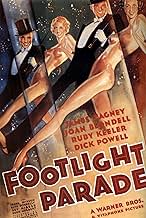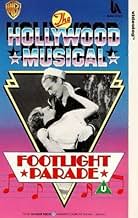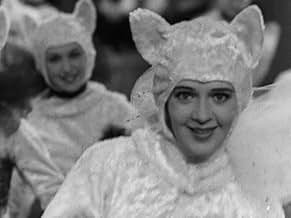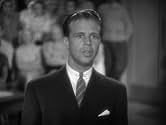Chester Kent struggles against time, romance, and a rival's spy to produce spectacular live "prologues" for movie houses.Chester Kent struggles against time, romance, and a rival's spy to produce spectacular live "prologues" for movie houses.Chester Kent struggles against time, romance, and a rival's spy to produce spectacular live "prologues" for movie houses.
- Awards
- 3 wins total
- Chorus Girl
- (uncredited)
- Chorus Girl
- (uncredited)
Featured reviews
Busby, of course, is the undisputed master of the Hollywood musical with "Gold Diggers of 1933" and "42nd Street" to his credit (as Dance Director). Footlight Parade is graced by hundreds of scantily-clad chorus girls, a Berkeley trademark. The elaborate dance numbers were shot with only one camera and Busby was the first director to film close-ups of the dancers. His obsession with shapely legs and "rear-view" shots is amply demonstrated here. The overall effect is highly erotic and mesmerizing.
Our boy Jimmy Cagney plays Chester Kent, a producer of "prologues" or short musical stage productions that were performed in movie theaters to entertain the audience before the talkies were shown. He's surrounded by crooked partners, a corporate spy, and a gold-digging girlfriend. Although Cagney had a solid background in vaudeville, this was the first film in which he showed his dancing talents. Joan Blondell is memorable as Cagney's wise-cracking, lovestruck secretary. And Ruby Keeler is adorable, as always.
The film climaxes with three outstanding production numbers, "Honeymoon Hotel", "The Waterfall", and "Shanghai Lil", each one a masterpiece and not likely to be duplicated in today's Hollywood where so-called "special effects" have replaced creative cinematography.
Claudia's Bottom Line: Clever and erotic, with some of the best musical production numbers ever put on celluloid. A thoroughly enjoyable Depression era romp.
Once more we have a film about a filmmaker fighting to stage a vision, here a preshow as opening act for the first talkies. He's a grunt, always storming in and out of rooms, yelling directions, now and then pausing to show the steps to the troupe or scream at a phone; but always fretting about new ideas to stage. He's played by James Cagney, whom we know best from tough-as-nails gangster roles. It's very apt casting. Cagney had many expressive talents, and a violent energy with the intuitive power to carry these into a performance.
But none of the ideas he comes up for the show seem like they've been very well thought out, they're all unfinished premises rushed with one foot out the door, so it's all a mystery how this strong-willed hack can give coherent shape to creative chaos. What kind of show he'll be able to put together. Money is staked on him, fortunes.
He's surrounded by three women, one for each number he's called to improvise. One is an ex-wife out for leeching money, another is his loyal secretary secretly in love. All three are fighting to seduce or be seduced, money is at stake again, and the art made with them.
It's all very enjoyable thus far, the rapid-fire banter and atmosphere of festive uproar. But it's not that it truly soars until we actually get to see on the stage how the various tribulations, that from our end so far seemed random and meaningless, were in fact shaping the vision that we get to see.
We drive back and forth around town to see these; the first number is about newly weds in the 'Honeymoon Hotel' with marriage slyly perverted as illicit sex that ends with bedroom eyes and mock happiness which we know will not last, and didn't for him, the other is a scene from everyday life on the street transformed on stage into the most gaudy spectacle with wood nymphs frolicking beneath cascading waters.
The third is the most stunning, because it substitutes for the internal processes that yield one happy end within another, both on the same stage. We knew our man was the author of these visions, the dreamer as it were, but was content so far to pull the strings from behind. Here an accident of fate forces him to get up on that stage and act out the part he was intuitively drawn to create: the number is about this man seeking out the woman of his dreams in a sort of smoky, semi-conscious stupor, and again the unforeseen circumstances - in this case, war - that keep love from them. Eventually he tricks both fates and us, the camera, to fulfill the dream.
So the happy end meant to take place in reality is pure Hollywood fiction, while the pure Hollywood fiction of the song and dance number reveals from machinations inside the soul a true purpose outside.
It is excellent stuff about the makings of images choreographed from the heart. Their power to articulate is this; art that reflects, salvages purpose from a life that appears incoherent, yet also reveals capricious fates of our own making that we have set in motion by simply living our part. Clearly this grunt could not have staged what he did, even with expert craft, if life around him had not seduced inspiration out of him.
First-rate Busby Berkeley musical from Warner Bros. with a terrific cast and the wonderful choreography Berkeley was known for. Most of the musical numbers are saved for the last half-hour but they're all great. James Cagney and Joan Blondell are lots of fun. They always had perfect chemistry. There's also a lot of snappy pre-Code lines, particularly from Blondell. Dick Powell and Ruby Keeler are also enjoyable. Nice support from solid character actors Frank McHugh, Guy Kibbee, Arthur Hohl, and Hugh Herbert. Fast-paced and highly entertaining. Essential for fans of Berkeley or the great leads.
Cagney is even doing a bit of singing in this one and also quite an amount of dancing. And it needs to be said that he was not bad at it. He plays the role with a lot of confidence. He apparently had some dancing jobs in his early life before his acting career started to take off big time, so it actually isn't a weird thing that he also took on some musical acting roles in his career. He obviously also feels at ease in this totally different genre than most people are accustomed to seeing him in.
The movie is directed by Lloyd Bacon, who was perhaps among the best and most successful director within the genre. His earliest '30's musicals pretty much defined the musical genre and he also was responsible for genre movies such as "42nd Street". His musicals were always light and fun to watch and more comedy like than anything else really. '30's musicals never were really about its singing, this was something that more featured in '40's and later made musicals, mainly from the MGM studios.
As usual it has a light and simple story, set in the musical world, that of course is also predictable and progresses in a formulaic way. It nevertheless is a fun and simple story that also simply makes this an entertaining movies to watch. So do the characters and actors that are portraying them. Sort of weird though that that the total plot line of the movie gets sort of abandoned toward the end of the movie, when the movie only starts to consists out of musical number routines.
The musical moments toward the ending of the movie are also amusing and well done, even though I'm not a too big fan of the genre itself. Once again the musical numbers also feature a young Billy Barty. he often played little boys/babies/mice and whatever more early on in his career, including the movie musical "Gold Diggers of 1933", of one year earlier.
A recommendable early genre movie.
8/10
http://bobafett1138.blogspot.com/
Did you know
- TriviaFirst film where James Cagney dances - showing off his vaudeville and stage experience as a song-and-dance man. Cagney lobbied Warner Bros. to play this role. He would show off these talents to their fullest in La Glorieuse Parade (1942).
- GoofsAfter the "By A Waterfall" prologue ends, the film cuts to the audience giving an animated and thunderous applause, but in the balcony there is no applause or reaction. In fact, there is no movement whatsoever. They are perfectly still which indicates that a photo or painting was used for the balcony audience and then merged with the live theatre audience. The same photo/painting was also used for the "Shanghai Lil" balcony audience.
- Quotes
Nan Prescott: You scram, before I wrap a chair around your neck!
Vivian Rich: [Angrily] It's three o'clock in the morning - where do you want me to go?
[Nan starts to speak, but Vivian immediately cuts her off]
Vivian Rich: You cheap stenographer...
Nan Prescott: Outside, countess. As long as they've got sidewalks YOU'VE got a job.
[Shoves her out, gives her a swift kick in the rump, and slams the door behind her]
- Alternate versionsThere is an Italian edition of this film on DVD, distributed by DNA srl, "VIVA LE DONNE! (1933) + AMORE IN OTTO LEZIONI (1936)" (2 Films on a single DVD), re-edited with the contribution of film historian Riccardo Cusin. This version is also available for streaming on some platforms.
- ConnectionsEdited into Busby Berkeley and the Gold Diggers (1969)
- SoundtracksA Vision of Salome
(1908) (uncredited)
Music by J. Bodewalt Lampe
Played during the prologue scene in the movie theater
Details
Box office
- Budget
- $703,000 (estimated)
- Gross worldwide
- $276
- Runtime1 hour 44 minutes
- Color
- Aspect ratio
- 1.37 : 1
Contribute to this page









































